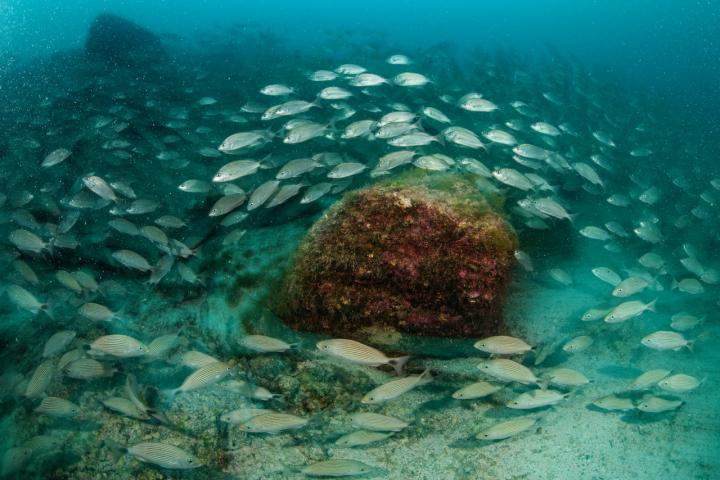

These are fish swimming along rocky reefs at Cabo Pulmo National Park
Credit: Octavio Aburto, Scripps Institution of Oceanography at UC San Diego
Researchers at Scripps Institution of Oceanography at the University of California San Diego were part of an international team that for the first time used hydroacoustics as a method for comparing the abundance of fishes within and outside marine protected areas (MPAs).
They found that the abundance of fishes was four times greater in Mexico's protected Cabo Pulmo National Park than in areas outside the park. Study authors said that hydroacoustics points the way toward a new, more cost-effective method of assessing fish populations.
“Managers and authorities in many countries spend a lot of financial resources assessing marine protected areas,” said study co-author Octavio Aburto, a marine ecologist at Scripps. “The results of this paper demonstrate that it is possible to use acoustic technologies to generate information about marine resources inside MPAs in a faster and less expensive way, reducing the costs for governments in ocean conservation.”
The study, “Hydroacoustics as a tool to examine the effects of Marine Protected Areas and habitat type on marine fish communities,” appears Jan. 15 in the journal Scientific Reports. The National Science Foundation, the Baja Coastal Institute, the International Community Foundation, David and Lucile Packard Foundation, and The Helmsley Charitable Trust funded the research.
Cabo Pulmo has been the site of several studies by Scripps researchers since 2002. In 1995, local fishermen led the creation of a 71-square-kilometer (27-square-mile) undersea park to protect the waters they fished. The current MPA has been identified as the most successful in the world in terms of maintaining a sustainable fishery in which fleets operate just beyond the boundaries of the MPA. There, as in other parts of the world, surveys of coastal marine life are often performed through underwater visual censuses taken by scuba divers.
Researchers surveyed the waters of the MPA using sound waves produced by hydroacoustic equipment mounted on boats to image schools of fish and other marine life. They performed transects, scanning the water column in rows. They similarly surveyed waters outside the MPA. Fish density, total biomass, and the size of individuals were significantly greater inside the MPA. In comparison with waters outside the MPA, animal abundance in reefs was as much as 50 times higher, “highlighting the importance of both habitat complexity and protection from fishing for fish populations.”
“Both hydroacoustics and marine protected areas are well-established but it is novel to use the former to assess the latter,” said study lead author Jack Egerton, now a researcher at the University of Texas who performed the work while at Bangor University in Wales, UK. “Through this, we have been able to see how important the Cabo Pulmo National Park is for fish populations in the area.”
Although acoustic surveys can be done much faster than underwater visual censuses, the researchers acknowledge that fish sizes can only be approximated and the method doesn't provide species-specific information. However, they concluded that the hydroacoustic method could still be useful in gauging the benefit of MPAs, as conventional survey methods are often prohibitively expensive and can be limited by issues such as diver depth limits and water clarity.
###
Study co-authors include Scripps postdoctoral scholar Andrew Johnson and researchers from Bangor University and the Centro para la Bioversidad Marina y la Conservación in La Paz, Mexico.












